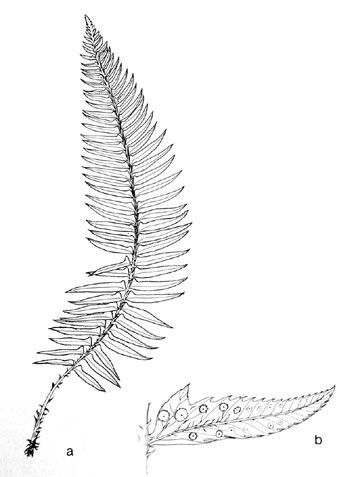| Polystichum munitum | ||
Sword fern | ||
|
Etymology
Munitum means fortified or protected.
Description
Rhizome: erect.
Frond: 150 cm high by 25 cm wide, evergreen, monomorphic, blade/stipe ratio: 5:1. Stipe: grooved, green, scales dense, red-brown to dark brown or nearly black, gradually diminishing in size above, vascular bundles: 4 or more, in an arc. Blade: 1-pinnate, linear-lanceolate, base slightly narrowed, glossy, microscales ovate-lanceolate to linear-lanceolate, with contorted projections, dense, below only. Pinnae: 35 to 50 pair, narrowly lanceolate, straight to falcate, 1--15 cm; base � cuneate, well developed ears; margins serrulate-spiny; veins free, forked. Sori: round, in 1 row between midrib and margin, indusium: peltate, central, sporangia: yellowish, becoming brown. Culture
Habitat: forest floor, only occasionally on rock, in mesic coniferous to moist, mixed evergreen forests.
Distribution: Alaska, British Columbia and Montana to California, disjunct in South Dakota, Guadalupe Island, Mexico.
Hardy to -20�C, USDA Zone 6.
Synonyms
Aspidium munitum Kaulfuss Dryopteris munita O. Ktze. Polystichum plumula Presl Aetopteron munitum House Nephrodium plumula Presl |
|
|
